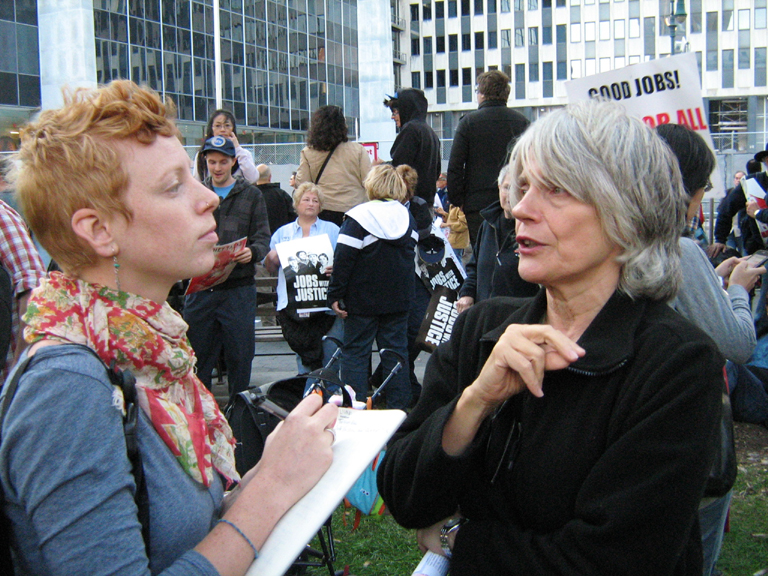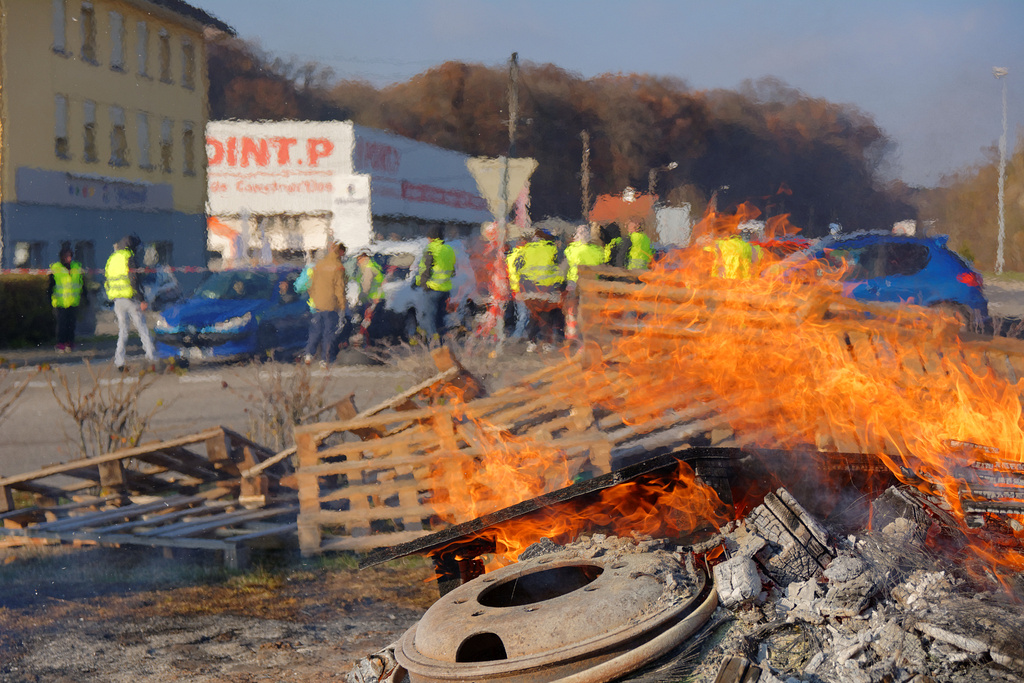
It has been two years since the explosive surge of the Democratic Socialists of America, now the largest socialist organization in the United States and the largest since the 1940s. And DSA has had some remarkable successes. Today as the country turns its attention to the presidential election of 2020, we ask: How DSA is doing? What is it accomplishing? And where is it going? What do the various caucuses and political tendencies within DSA propose as a future direction for the group? Is there a genuine left wing of DSA, and if not, what is the alternative?
In the last two years the Democratic Socialists of America has become a phenomenon on the American left with more than 50,000 members in scores of chapters in every state of the union. DSA has now become the largest socialist organization in the United States since the 1940s when the Communist Party had about 100,000 members. And alongside DSA, the Young Democratic Socialists of America is also spreading across college campuses bringing thousands of young people into the orbit of socialism.
DSA’s spectacular surge has been accompanied by a growing appreciation of socialism among Democrats. As the Gallup Poll reported in August of 2018
For the first time in Gallup’s measurement over the past decade, Democrats have a more positive image of socialism than they do of capitalism. Attitudes toward socialism among Democrats have not changed materially since 2010, with 57% today having a positive view. The major change among Democrats has been a less upbeat attitude toward capitalism, dropping to 47% positive this year — lower than in any of the three previous measures.
Many DSA members hope that given these attitudes they can recruit more Democratic Party’s progressives and also influence the party itself, though there is great debate about the strategy, the eagerness of some accompanied by the skepticism of others.
All of this began with Bernie Sanders’ 2016 campaign for the Democratic Party’s presidential nomination. When Sanders called himself a “democratic socialist,” young people went to Google to search for the term and found DSA, read about DSA and its ideas and were impressed. Social media—and some DSA wranglers—did the rest and soon the organization had 20,000 members. Then Donald J. Trump won the presidency in November 2016 and, frightened by the prospect, another 20,000 or so joined. And most recently Alexandria Ocasio Cortez’s victory in June a Democratic Congressional race, defeating Democratic Caucus Chair Joe Crowley brought in a few thousand more. Nothing is simpler than joining. No questions asked. No probationary period. Just go to DSA, ask to join, pay the minimal dues, and presto: you’re a member.
Here was a generation of young people, largely from middle class families, who, after having been thrilled by President Barack Obama, had become deeply disappointed in him. Even if well educated they frequently carried the burden of a large college loan debt, and many of them, often highly skilled, became contract laborers with little job security, while others serve beer in the bars or wait tables in the clubs. They have grown up in a nation engaged in a permanent war in Iraq, Afghanistan, and half a dozen other countries while at the same time they have observed—if they have not personally been involved in—the Occupy Wall Street movement and Black Lives Matters. They have been influenced by the successful fight of the LGBT movement to end “Don’t ask don’t tell” and to gain marriage equality. While mostly white, in a nation where whites will soon be a minority, their college experience and then their jobs brought them into contact with Asian, Latino and black people and exposed them to all of the debates over identity politics. Out of all of this they have come to DSA with idealism and tremendous desire to make a better world.
Thousands of DSA’s new members, mostly young people between 25 and 35 coming out of the broad progressive milieu—most with no previous experience in the social movements or left groups and little experience beyond the Bernie campaign—signed up and soon became activists not only in political campaigns but also in DSA’s working groups that are involved in a variety of social movements, from health care for all to fights for low income housing, from opposition to police racism and abuse and defense of immigration rights to the struggle against climate change, from union organizing campaigns and strike support to building a socialist feminist movement. Participating in civil disobedience in various cities a several new DSA members have been arrested—their first arrests—fighting against Trump’s kidnapping of immigrant children or for some other worthy cause.
DSA chapters—divided in big cities into several branches—introduce members to socialism, educate members about the history of the left, and provide classes on Marxist theory. Sprinklings of exiles and refugees from other leftist organizations who joined DSA have mostly brought leaven to the loaf. And in between all the meetings and protests there are social events at the bars—meet-ups of black or Latinx socialists, of retail workers or teachers, or just gatherings after the chapter meetings—where over the suds every conceivable issue is discussed.
We have not had such a vibrant left in America for forty or fifty years, no socialist group this big in 70 years, and nothing exactly like this ever. Everyone on the left should celebrate this remarkable development. Which is not to say there are no problems, but many are good problems, almost all of them necessary ones, and only a few of them seriously troubling. The real issue is the direction: where is DSA going? And the biggest question regarding the group’s future is its relationship to the Democratic Party, a party itself in flux. Will DSA, whose rebirth began in Sanders Democratic Party primary campaign, be able to attain escape velocity and become a truly independent socialist organization, or will the greater gravity of the Democratic Party—its size, money, influence, connections, power—succeed in keeping DSA within its orbit?
From Spring’s Halcyon Days to Fall’s Sturm und Drang
Early 2017: those were the halcyon days. The enormous influx of members transformed DSA into what was virtually a new organization. The individuals who had joined in ones and twos or in small strings of friends found themselves in meetings with many others much like themselves, forming new friendships as they revitalized old chapters, formed new chapters, and elected local leaderships. Everywhere they established new working groups and marched together behind DSA’s red banners in what were for many their first picket lines or protest demonstrations. DSA’s National Director Maria Svart and the organization’s miniscule staff did a remarkable job of keeping on top of a group that doubled in size every few months, advising new chapter leaders, creating new structures and publications, sending out inspiring emails urging members to keep up the fight. The goodwill among the members and the good nature of most of them was remarkable to those of us who had come out of an older left made up of smaller groups formed in the social upheavals of the 1960s and 1970s, and then tested in the long dry spell of the 1980s and the intermittent struggles of the 1990s and 2000s, discouraging and embittering some. Then suddenly: the new DSA. A breath of fresh air.
The DSA newcomers, as I said, joined and found others like themselves—perhaps too much like themselves. Most of DSA new members were college educated people, many of them here in New York, for example, employed in technical jobs or with professional careers in tech, publishing or design. In Los Angeles there’s quite a contingent of film industry workers. Others everywhere form part of the new precariat employed in coffee shops, restaurants, and bars or working a couple of gigs to put together the rent with their roommates. Few DSAers are married or have children. And few are over 50 or even over 30. Most members are white and the proportion of people of color in DSA is less than that in American society as a whole and similarly with union members. And men generally outnumber women, though the difference between the two is not extreme, certainly not as out of kilter as in some small left groups that are practically boys’ clubs. LGBT members have found themselves in a group, which if not always as sensitive to such issues as it might be, has proven capable of learning. Everywhere DSA members are conscious of these race and gender issues and anxious to make the organization more representative of the American working class as a whole.
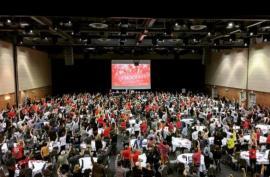
At the August 2017 DSA Convention, its ranks swollen with younger, more radical members, DSA moved to the left, adopting a series of measures that seemed to break with the group’s social democratic past. The convention delegates voted to leave the Socialist International (SI), based on the argument that the European Social Democrats had become the enforcers of neoliberalism and austerity while SI affiliate parties in many developing countries headed up authoritarian governments. The convention also voted to support the Boycott, Divest, Sanctions (BDS) campaign and to oppose efforts to criminalize the movement. The delegates, wanting to turn DSA in a new direction, also voted to establish a People of Color Caucus and a Labor Commission. And finally the convention made a single-payer health care system a national objective.
Not surprisingly, given the rising temperature of politics in the country and the crises in the major political parties, as that last DSA convention approached significant political differences had already appeared in the DSA, differences that reflected debates on gender, race, and class taking place in the academia, in the media, and in the social movements. Consequently, for the first time in the group’s history, caucuses and rival slates made their appearance and there was a serious scuffle if not a battle for leadership of the group. Following the convention, strife continued among a scribbling minority on social media where snide matched snark and ad hominem Tweets and posts sometimes verged on character assassination, though the great majority of the members remained aloof from the mud and the dreck. We seem to have come through the worst of that Sturm und Drang—or to have become habituated to it—and have moved on to more serious discussion and debate over our future.
Harrington and the DSA Old Guard

We should pause a moment to put DSA today into a little historical perspective. DSA’s roots go back to the social struggles of the 1950s and 1960s and the civil rights and anti-war movements. In those days, the old Socialist Party in which DSA has its roots—that is, the party of Eugene V. Debs who went to prison for opposing World War I—had moved to the right and come out as a supporter of the U.S. war against Vietnam.
The Socialist Party’s anti-Stalinism too much resembled the liberal, State Department anti-Communism of Americans for Democratic Action (ADA). In the late 1960s, Michael Harrington, the SP’s youngish, leftish face (he was just 40 years old then) alienated the young radicals of Students for a Democratic Society (SDS) because he told them they weren’t sufficiently anti-Communist, causing the SP to lose its relationship to the largest and most important left movement of the 1960s. SDS went off to be taken over by the Stalinist of the Progressive Labor Party ((at that time pro-Communist China) and the radical liberals of the Revolutionary Youth Movement (RYM) and the Weathermen who broke windows and built bombs and carried out some bombings and armed robberies, killing a few of themselves and a couple of others. After Harrington turned his back on SDS, only a small group found its way to socialist politics through groups like the International Socialists. (I was one of those then.)
The Socialist Party’s support for the Vietnam War finally drove Harrington out of the party in 1972, and the following year he and his followers created the Democratic Socialist Organizing Committee (DSOC). Harrington had a strategic perspective that inspired the new organization. As he argued in his book Socialism, he believed then that if the unions, the civil rights organizations, and the anti-war movement could be brought together within the Democratic Party that they could drive out the southern racists and the corrupt big city machines and transform the Democratic Party into a labor party. At that time, Harrington and his friends had ties to both black leaders of the civil rights movement and to important leaders of major industrial and public employee unions, while the anti-war movement was still in the streets. Harrington’s strategy seemed to have legs.
Harrington’s plan of working within a capitalist party represented a fundamental break with socialist theory and practice since Karl Marx initiated modern socialism in Europe or since Debs had led the movement in America. Socialists had historically rejected involvement in capitalist political parties, believing that working people needed their own political party if they were to overthrow capitalism and establish a socialist order. But Harrington was not the first one to give up the Marxist position. Over the century from 1870 to 1970, the various left parties had by various paths come to reject Marx’s admonitions about the role of capitalist parties and the capitalist states.
The Communist Party had during its “Popular Front” period in the 1930s and 1940s, worked in an alliance with the progressive Democrats and in other countries with other capitalist parties, even conservative parties, justifying its position by the need to stop the Nazis. During that era, when the CP’s American leader Earl Brower proclaimed that “Communism Is Twentieth Century Americanism,” the Communist Party had grown to 100,000 members with an estimated one million people in their periphery. During the same period, in Europe the Labor, Socialist, and Social Democratic parties, after more than a century of involvement in bourgeois politics and following the disastrous civil wars world wars of 1914-1945, had emerged as reformist capitalist parties. The Socialist Parties now managed capitalism. Their strategy in places like Scandinavia became a model for Harrington’s program for America.
Harrington’s political position, with its resemblance to the Communists’ Popular Front and to European Social Democracy, made it possible almost a decade later for DSOC to merge with the New American Movement (NAM), a New Left organization formed in 1971, some of whose leaders were former pro-Soviet Communists, while some others inclined toward Communist China or Fidel Castro’s Cuba, and in general many were sympathetic to the “Third World” nationalist movements. The NAM also brought concerns about feminism and the environment that had not previously formed part of the DSOC worldview. The combined organization had 6,000 members, 5,000 from DSA and 1,000 from NAM. It was at this point that DSA staked out its “big tent” approach and conception of a mutli-tendency organization.
The old DSA, having broken with its Marxist origins and with revolutionary socialism, required a new theory, and its intellectuals found it in interpretations of Antonio Gramsci’s Prison Notebooks and in the writing of thinkers on the left of the European socialist parties like the French writer André Gorz, the Greek-French political scientist Nicos Poulantzas, and the British sociologist Ralph Milliband. All of these intellectuals, starting with Gramsci, emphasized the theory of hegemony, the relative autonomy of the state from the capitalist class, and the political struggle within the existing capitalist parliamentary governments. As interpreted first by Richard Healey and later by Joseph Schwartz, socialists should, first, adopt Gramsci’s view—at least for the present—that we are engaged in a “war of position,” that is, an attempt to build organizations, influence politics, and win hegemony, while eschewing a “war of movement” that is, a head on revolutionary confrontation with the state. Sometimes there was a suggestion that the long, slow, gradual war of position would eventually lead to the war of movement, to revolution, though by postponing the “war of movement” indefinitely, revolution receded into by infinite regress not into the future but into oblivion.
Secondly, DSA’s theorists argued, socialists should emphasize Gorz’s theory of “non-reformist reforms,” that is, profound reforms that would tend to break out of the limits of the capitalist system. The unaddressed problem was that such reforms would either tend to strengthen the capitalist state or would tend to make capitalism less profitable, leading employers and politicians to turn to the right and to repression. If the latter, then the right would then initiate the “war of movement” for which the left had not been prepared. In any case, in the hands of DSA’s intellectual and political leaders, all of this theory served primarily to justify work in the Democratic Party. So DSA from its founding in 1982 worked in the social movements—that were then in the doldrums—and often endorsed candidates for election in the rightward moving Democratic Party. In the 1990s DSA grew to 10,000 members as it worked closely with the Congressional Progressive Caucus to oppose President Bill Clinton’s regressive policies. DSA’s commitment to work in the Democratic Party, to an alliance with the more progressive labor bureaucracy of the United Auto Workers, AFSCME, and the IAM, and its soft support for Israel, practically defined it as a liberal organization, just as old style liberalism went into crisis and decline.
The new DSA that emerged two years ago after “the Bernie Bump” was fundamentally different in temperament. It was made up of people furious with Hillary Clinton and the Democratic Party National Committee, and with its chairwoman Debbie Wasserman-Schultz. At that moment, many hated the Democratic Party altogether. Some wanted Bernie to run as an independent or to create a new party. The seething anger at the Democrats made possible DSA’s 2017 Convention break with the Socialist International and the other progressive resolutions passed at that meeting—but it didn’t lead to a break with the Democrats. And as we will see, the old DSA strategy based on an orientation to the Democratic Party remained a powerful and attractive current. But first, let’s look at DSA’s social movement activism, which constitutes most of the organization’s actual work, because we want to consider the relationship between social movement activism and politics.
DSA at Work
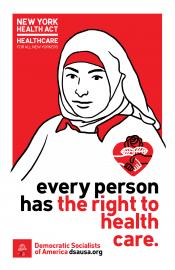
With its new members, DSA has over the last two years been able to launch more campaigns, enter into more coalitions, and simply do vastly more work. DSA’s national health care campaign—We Need Medicare for All—gives the lie to theoretical debates about an irrepressible conflict between economic reductionism and concern for particularly oppressed groups by proposing a broad economic change that would particularly improve the conditions for women and people of color. While Medicare for all would be good for all, it will be especially good for the working poor, for low-wage workers, for the precariat, for African Americans, Latinos, and women. In New York City the Socialist Feminist Working Group has played a leading role in the health care campaign, canvassing neighborhoods and phone banking for the New York Health Act. Today the fight for health care for all stands at the center of DSA’s political program.
The Immigrant Justice Working Groups around the country have been fighting the role of the Immigration and Customs Enforcement (ICE) agents who frequently arrest people showing up in court for their immigration hearings, as witnesses in criminal cases, or simply as standers by who fit the profile of immigrants, whatever that is. Some DSA members have been arrested in protests against these practices. In New York DSA’s IJWG protests have been accompanied by the presentation of a petition with thousands of signature demanding an end to ICE in the courts to New York State Chief Judge Janet DiFiore, who has permitted their presence. NYC DSA has worked with groups such as the New Sanctuary Coalition to educate immigrant communities about their rights and how to protect themselves from unlawful ICE actions. The DSA IJWG activists have also mobilized to show solidarity with the recent immigrant caravans, some traveling across the country to welcome those seeking refuge and asylum at the border. Some DSA members from various chapters are now in Tijuana and San Diego to offer assistance to the migrants.
The fight against gentrification and rising housing costs, as well as the protection of public housing also constitutes an important part of DSA’s activism in many cities. Almost everywhere this is a struggle against powerful banks, realtors, and construction companies by working class and poor communities, often made up largely of low-income people of color. DSA joins with these housing activists and with community organizations to educate renters about their rights, sometimes creating tenant unions, and organizing neighborhood meetings, protest demonstrations, and testifying at public hearings.
Sometimes DSA’s work in this area involves lobbying and legislation. These fights may pit DSA socialists against supposed progressive local politicians. In Brooklyn DSA joined with the Crown Heights Tenant’s Union to oppose the transformation of the city-owned, huge, block-square Bedford Union Armory into luxury housing. The coalition took the fight to the Democrats’ progressive city council where, while it didn’t win all it asked for did win many more affordable housing units. DSA also works on housing legislation. In California, DSA’s housing group supported “Proposition 10, the Affordable Housing Act, [which] would allow communities to expand and strengthen tenant protections, legalizing rent control for every California renter regardless of what kind of home they live in.” The legislation was defeated 6.3 to 4.2 million votes. But the defeats on these issues in New York and California are only battles in a much longer war and the question, to which we turn below, is what lessons are being taken from these experiences
Into the Labor Movement
DSA has made labor a focus of its activity and, in a way different than it did in the past. Harrington and the old DSA had had an alliance with the liberal wing of the labor bureaucracy, most importantly Walter Reuther of the United Auto Workers. Reuther and his successor Leonard Woodcock, both former socialists who supported the most liberal Democrats, fought for higher wages and benefits for workers, but neglected rank-and-file workers demands for more a more human workplace. Those leaders also neglected the issues of black autoworkers. And, when the black autoworker rebellion took place in the late 1960s with the organization of the Dodge Revolutionary Union Movement (DRUM), Walter Reuther called the black workers “racist” while another UAW official called them “black fascists.” The alliance with the UAW officials and other union leaders put the DSA at odds with activists in the unions organizing a rank-and-file movement in opposition to both the auto companies and the union leadership. Of course, DSA also always had some dedicated worker activists and local union officials who tried to fight the good fight even when their leaders failed to, but by the 2010s there weren’t many labor activists left.

Today the Democratic Socialist Labor Commission has nearly 700 members nationwide, described as: “union members and stewards, union staff, workers center activists, union officers, labor journalists, union retirees, students in labor solidarity groups, labor-oriented intellectuals, or in any other kind of role in the movement!” DSA’s monthly newspaper, The Democratic Left, recently published a special labor issue that made clear the group’s commitment to more democratic and militant labor unions. DSA’s labor work has been strengthened by several members of Solidarity who joined DSA, many of whom who have years of experience in the unions and have played an important role in helping to organize and to orient DSA’s labor work.
The Solidarity members and many other DSA’s are committed to a rank-and-file approach, described by Kim Moody decades ago and as laid out succinctly in an article Jane Slaughter wrote for the Democratic Left. Rank-and-file organizing by workers on the job and at the unions’ grassroots is intended to fight the bosses and when necessary to fight union officials who stand in the way; it is meant both to build the labor movement and to recruit workers to socialism and to the DSA. While some DSA labor activists may have other approaches, this seems to be the dominant trend at the moment. DSA members are now working with Labor Notes, the labor education center that has helped rank-and-file labor activists come together in various unions to build a more militant and democratic labor movement.
While in the 1970s many young leftists went to work in the mines, in steel mills, auto plants, at the telephone company, or as truck drivers and dockworkers, among many others, today DSA members look to other industries. As Slaughter wrote, “To build this fight-from-below, some DSAers are getting jobs in multiracial workplaces that show potential for ferment. These include teaching, healthcare, and logistics.” DSA has on its website an article titled “Why Socialists Should Become Teachers,” which talks about the role that a few DSA members played in the recent West Virginia teachers strike,
A few DSA members that were teachers in West Virginia public schools began having conversations about new austerity measures facing public employees. Our wages had been stagnant for years—unlike our healthcare costs, which were climbing. We formed a reading group, held brainstorming sessions, and quickly agreed that winning our demands would require militant action. We had no idea that we were laying the groundwork for what would culminate in a historic, successful nine-day strike that spread like wildfire to Oklahoma, Kentucky, Arizona, Colorado, and beyond.
The article goes on to make a compelling case for DSA members to take up a career in the field of teaching. A number already have and not only in West Virginia. Other DSA members have “salted,” that is taken jobs to support union organizing campaigns, in unorganized warehouses. All of this suggests that DSA stands poised to play a role in the labor movements of the coming decade and if successful—and this is the hope—could begin the process of transformation into a largely working class organization.

The Issue of Race
Given the long history of racism in America from slavery and Jim Crow to pervasive discrimination throughout the last century and the phenomenon of contemporary “color-blind” racism, it is not surprising that DSA like every other institution in America would also have challenges in dealing with the race issue. We in DSA find ourselves dealing with a debate over economic reductionism on the one hand and identity politics on the other, a false dichotomy in my view, but also with tensions between members of various ethnicities and various politics over the handling of race issues. A recent article in The New Republic, “Do America’s Socialists Have a Race Problem?” suggested that DSA, and in particular its Momentum/The Call, an important national group that plays a leading role in the East Bay and Philadelphia chapters, had dealt disastrously with racial issue. The article painted a false picture of an organization about to be torn about by racial issues.
In response, nearly a dozen DSA members of color responded with an article in The Call criticizing the author’s method and distortions in the article. The authors’ write:
Contrary to what Salazar’s piece implies, all political tendencies within DSA agree on the importance of fighting racial oppression; all agree that it’s a problem that DSA is largely white; and all agree that DSA must be a democratically-run socialist organization. The main point of disagreement that remains is how to most effectively address these issues and concerns.
Absolutely true.
The collective article in The Call suggested that DSA would in the long run overcome its most important race problems—the small percentage of members of color and particularly black members and a lack of a base in communities of color—through it work in the social movements, in the unions, and in political campaigns that would bring about new recruits and closer community ties. While there is some truth there, involvement in movements and growth in members of color will have an impact, but the organization most also grapple with theories and attitudes, with internal structures and political processes. The New Republic piece, focused as it was on the issue of racial tensions in DSA, made it seem as if DSA was afflicted with race problems, while the article in The Call does not appear to recognize the depth of feeling and deep concern among many DSA members about the group’s theory and practice in confronting racism.
We might note that Adolph Reed, Jr., who is not a DSA member, enters into this debate within and about DSA with the worst possible and least useful terms—Which Side Are You On?—demanding that the left choose between a social democratic program and the politics of racial identity politics. Once again the false dichotomy.
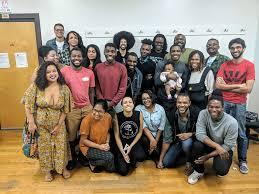
DSA is not the organization portrayed by Salazar, but The Call’s defensive response doesn’t address the issue adequately either. Momentum/The Call tends to emphasize a universal economic program, while other members—while not necessarily interested in promoting identity politics—want more emphasis on the issues of racial and gender oppression and on the need for the self-organization of oppressed groups. We need a political approach that understands that capitalism leads to both the exploitation of workers and the oppression of blacks and Latinos, and women and LGBT people, and so we need the self-organization of and the relative autonomy of those groups and their struggles within the broader fight for socialism.
Politics: Socialists and the Democratic Party
While DSA is and does many things, electoral politics has probably galvanized and mobilized more members than any other activity. This is not surprising given the fear that President Donald J. Trump’s authoritarian white-nationalist government is perceived by many as the first step to something worse and even to fascism. Electoral politics offers the hope of actually changing the people and the parties that dominate government, as well as altering governmental policies. And the work is rewarding. Political campaigns provide opportunities for many to contribute: creating databases, developing and designing campaign materials, canvassing neighborhoods, identifying voters and in the end getting out the vote. Electoral work, knocking on doors and talking with people in their homes can be interesting and fun, a real learning experience for young people especially about who lives in the neighborhood and what those people are thinking. In some areas, such as New York City, DSA has been able to mobilize hundreds of members and in one as many as 2,000 in local campaigns. The sense of having worked in a common activity is also important to DSA in creating a common sense of identity.
The work has been so successful that today most people probably know of DSA as the group that elected two of its members, Alexandria Ocasio Cortez and Rashida Harbi Tlaib, to the U.S. Congress as well as another, the controversial Julia Salazar, to the New York State Legislature. Other DSA candidates also won election to their state legislatures: Mike Sylvester in Maine, Gabriel Acevero and Vaughn Stewart in Maryland, and Summer Lee, Sarah Innamorato and Elizabeth Fiedler in Pennsylvania. Many other socialists won municipal elections or wee elected to Democratic Party positions. Socialist organizations have seen nothing like this since the Socialist Party of America of the 1900s—though the strategy is quite different than it was then. The Socialist Party of that era ran candidates on its own ballot line, not in another party. Eugene Debs, the perennial presidential candidate and most prominent leader of the SPA, told the voters: “It is for me to say to the thinking workingman that he has no choice between these two capitalist parties, that they are both pledged to the same system and that whether the one or the other succeeds, he will still remain the wage-working slave he is today.”
DSA, on the other hand has decided to run most of its candidates as Democrats, and though the long-term strategy remains somewhat vague, it may encourage illusions that the Democratic Party can be reformed or taken over. Does DSA, like the old Harringtonites, have such a strategy? Or is it using the Democratic Party simply to build its own organization and its own electoral machines? There are many views of this question within DSA, including some DSAers who don’t support running in the Democratic Party at all.

One can see the problems with work inside the Democratic Party when one looks at the record of Alexandria Ocasio Cortez, a DSA member whose victory in a Democratic Party congressional primary election in New York stunned the country and thrilled DSA members. Today Ocasio Cortez is an exemplar progressive participating in an illegal demonstration in Nancy Pelosi’s office to demand a serious Democratic Party position on global warming, calling for a Green New Deal, opposing the Amazon deal in New York City, and supporting laid-off workers. But Ocasio Cortez also caused consternation in DSA, when she came out in support for all Democrats, thereby including Andrew Cuomo, early in September 2018. DSA members by and large loathe Cuomo and her support for him shocked many. The New York City DSA leadership criticized Ocasio Cortez for her endorsement of Cuomo and other Democrats, writing, “…we reject the illusion that the Democratic Party is, or will become, an institution serving the interests of the U.S. working class.”
She also shocked many DSA members with her Twitter message upon learning of the death of Senator John McCain:
John McCain’s legacy represents an unparalleled example of human decency and American service. As an intern, I learned a lot about the power of humanity in government through his deep friendship with Sen. [Robert] Kennedy.
That a socialist, and presumably an anti-imperialist and an internationalist, could praise as “an example of human decency” a man who bombed Vietnam, supported the invasion of Iraq in 2003, called for bombing Iran, and ran a racist campaign against Obama was unacceptable to many in DSA. Incidents like these have raised questions not just about Ocasio Cortez but about the Democratic Party strategy.
So what next? Some in DSA have already come out for Bernie in 2020, arguing that early involvement in his campaign will once again present progressive economic and social program, popularize socialism, and perhaps recruit tens of thousands more to DSA. Whether or not the Bernie phenomenon can repeat itself remains in question. There is no evil Hillary Clinton as a foil in the primary. He will have competition from a host of other “progressive Democrats.” He will have to deal with charges of sexism in his 2016 campaign. His platform will not be unique since the other candidates who will be his rivals have now adopted many of his ideas, in fact the whole party may adopt them for 2020—in diluted and sometimes corrupted form. Having spent two years campaigning for Democrats, he does not have the reputation as an independent that he once had. And the presence of a socialist candidate in a presidential election will no longer be a novelty. Then too, Bernie will be 79, an age many believe is too advanced for a president. He would then be 83 at the end of his first term and 87 at the end of a second, which is always a calculation in presidential elections. Such issues must affect people like Ocasio Cortez and many other progressives who have hesitated to endorse Sanders, at least so far.
While DSA likes Sanders, it is not clear that Sanders values DSA. Sanders, after all has his own electoral organization, Our Revolution, and while some DSA members work on its staff and are active within it, it does not seem that they any significant political role. At the Sanders Institute’s inaugural gathering in Vermont in November and December, DSA members were not prominen. The only DSA member among the speakers was Cornel West, a major black intellectual, but a nominal DSA member who plays no role within the organization and is not associated with it in the public’s mind. So some in DSA would like to use the Sanders campaign to boost its organization, though it is not at all clear that Sanders sees any special role for the group in his operation.
The Context at the Moment
As we turn to DSA’s future, we should consider the state of the country today. The United States, despite what economists, the media, and politicians call a booming economy, remains in turbulent political times as it has been since the 2008 Great Recession. Trump, speaking to some victims of the economic crisis and to those who feared losing their social status, created a new populist political force, based on the conditions created by rightwing Republicans and the failures of Barack Obama, Hillary Clinton, and the Democrats. Trump and the Republicans have since 2016 succeeded in hollowing out political democracy through gerrymandering and voter suppression in a variety of forms, they have attacked and undercut social programs, undermined environmental policies and regulations, criminalized immigration and terrorized immigrants, while at the same time enoucraging racism and contributed to the growth of a far right that includes white nationalists and neo-Nazis.
The country has for two years verged on a Constitutional crisis as Trump has striven to create a unitary government with the Republican control of all three branches tending toward one-party rule and presidential domination, a situation attenuated but not resolved by the Democratic Party’s gains in the mid-term elections of 2018. When thwarted by the courts, Trump has attempted to rule by decree. Returning to the economic situation, the stock market has been erratic and there are fears of a coming economic crisis in many quarters. Throughout all of this, Trump, who remains in contact by Twitter with his 55 million followers, has held on to the 35 percent of the American population that approves of him and his policies. It remains altogether possible for him to win the next presidential election.

Given this situation, as we now go into the political campaign for the presidency in 2020, with the Democrats deeply divided and an array of twenty some liberal and progressive contenders vying to become the party candidate, tremendous political and popular pressure will build to support first, in the primary, a candidate “who can win,” and then in the election to back any Democrat against Trump. And similar forces will come to bear all down the ballot line—Senators, Representatives, governors, mayors, and city council members—with Democratic Party progressives playing the key role in attempting to pull those on the left into the vortex, into the maelstrom of what an older generation called bourgeois politics. And behind this will be, in fact, the bourgeoisie, with its control of finance and industry, of the media and much of the social media, pouring billions of dollars into the coffers of PACs and buying up politicians wholesale.
Toward the 2019 Convention
What does DSA propose to do in these times? DSA, of course, being political and being made up of that most mercurial of elements, ordinary human beings, is not united. Within DSA various currents of opinion, vague political tendencies, and organized caucuses discuss, sometimes debate, and at the convention to be held in August 2019 will vote on the organization’s leadership and policies, vote on its future.
Formally, that is constitutionally, DSA is a genuinely democratic organization, though the rapid growth of the organization, the increasingly dense proliferation of chapters, working groups, and committees, the adoption all over the country of scores of local by-laws and regulations, and the large proportion of new members with only a year, two or three in the group means that real democratic decision making has sometimes been hard to achieve. Consequently, some leaders held over from the old Harrington DSA, staff members whose focus is on maintaining the organization, and the attractions of political campaigns in the Democratic Party, as well as the relatively low level of struggle in the labor and social movements in the country, have meant that DSA has continued to move along its historic social democratic trajectory, despite the influx of thousands of new, young, and often radical members. The DSA ship wobbles in its orbit, but so far has not reached escape velocity that would allow it to head towards an independent political perspective.
The old DSA, that is before the Sanders campaign had already defined itself as a big tent and constitutionally permitted the existence of organized political caucuses within the group, though at that time there were none. Even now, most DSA members don’t affiliate with or even identify with national caucuses and the caucuses that exist don’t capture or reflect the diversity of views of all DSA members. Most DSA members have formed political connections through friendship networks coming out of the chapters or working groups. In small cities, towns, and rural areas, DSA members may have strong ties because they feel themselves to be part of a beleaguered radical minority. Some DSA members feel more comfortable with lose networks and a publication such as Build that tends to emphasize local community base building, rather than with political caucuses. Organized caucuses, however, are likely to play the strongest role at the coming convention.
While the first real caucuses began to appear just before 2017 convention, when a few caucuses developed, today there are several, some claiming several hundred members. Until a few months ago DSA has slew of caucuses from the the self-proclaimed “Marxist” Momentum/The Call to the anarchist Libertarian Socialist Caucus, from the more social democratic old guard of the North Star Caucus now with some new members, to the process and identity-oriented Praxis Caucus and the revolutionary socialist Refoundation Caucus. Surprisingly, Praxis and Refoundation disbanded in 2018, while Momentum/The Call is planning on holding a national meeting to formally launch its caucus in early 2019. And, meanwhile, a new Communist Caucus, has made its debut. Let’s turn to look at these various alternative leadership groups.
The North Star Caucus
Many of the signers of the North Star Caucus statement were members of DSOC or of NAM and have been members of DSA for decades; they represent the organizational and political continuity of of the group. A number have been leaders in their communities, in social movements, and in the labor unions for just as long, though they are now also joined by some younger members. The first principle of the caucus is this: “The defeat of Trumpism and the Republican majorities in Congress and the states is a strategic imperative for democratic socialists.” It is a position that by deduction commits the caucus to support of the Democratic Party. The statement goes on to read:
To defeat Trumpism and the Republicans, we must recognize that the Democratic Party’s decades-long acquiescence to neoliberal policies—austerity, privatization, deregulation and corporate-dominated globalization—has played a role in the rise of racist, far-right populism. The Democratic Party has been too passive as these neoliberal policies have led to the decimation of unions in the United States and to the socioeconomic devastation of large swaths of its working class.
What this ignores, of course, is that the Democratic Party was not simply acquiescing and being passive, but that it played an active role in the adoption of neoliberal policies and austerity, with the Clintons and Obama having a major part. It is this view that sets North Star apart from the other caucuses formed by younger members, which take a far more critical view of the Democrats.
The Communist Caucus
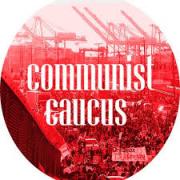
The Communist Caucus, which was previously simply a local group in the Bay Area, has announced that it will now become a national caucus. The core of the Communist Caucus comes from a group of Bay Area leftists who were inspired by the Italian Marxists of the 1970s and “current left-communist formations like Endnotes.” They entered DSA’s East Bay chapter and became involved in housing organizing with the goal of building tenant collectives and disrupting capital flows. Today, “Others come from a more ideological standpoint, many of which are left-communists, syndicalists, class struggle anarchists, post-trotskyist-ish, etc.”
The Communist Caucus sees its role as combating “the Jacobin Magazine-sponsored reformist agenda of working within the Democratic Party (see Seth Ackerman for an example).” As a spokesperson for the Communist Caucus said:
We want to help newly politicized members get involved in organizing efforts that may lead to actual disruptions of capital, as it exists on an everyday level. Doing this type of organizing means moving away from a liberal model that makes reformist demands on the state by way of organizing potential “voters.”
They oppose within DSA “other groupings that are, in our view, social democratic.” They say that they do not oppose participation in elections in theory, but they offer no strategy for independent political action to the left of the Democrats.
While the Communist Caucus puts its emphasis on organizing, its only significant project so far is its housing work, which may not be enough to convince others that it has a way forward. Whether or not the Communist Caucus can develop a national following and play a role at the DSA Convention in 2019 remains to be seen.
The Libertarian Caucus
Ideologically similar to the Communist Caucus, though less strident, the Libertarian Socialist Caucus, which claims some 700 members nationally, defines itself this way:
We take libertarian socialism to encompass those parts of the socialist movement (including syndicalists, council communists, anarchists, cooperativists, and municipalists, among many others) which have historically seen the surest path to socialism as residing in the creation of independent institutions in civil society that give the working class and ordinary people direct power over their lives.
While the list of radical tendencies they incorporate includes people who hold a variety of views, the Libertarians can be thought of as opponents of centralism and believers in what an earlier generation called “participatory democracy.” The caucus stands for things like “community councils,” “mutual aid,” and a strategy based on “dual power.” By dual power they mean the construction of local anti-capitalist institutions that can over time be federated into an alterative economic structure. Their “Dual Power” strategy document offers a number of examples, from the Spanish General Confederation of Labor to Cooperation Jackson, though they do not discuss the DSA’s actual role. Leaning more toward the historic models of anarchism than toward those of socialism, still, oddly enough, the Libertarian Caucus has in general accepted DSA’s electoralist strategy. Despite its reported numbers this caucus seems unlikely to have much influence on the DSA Convention 2019, even though many members like things like community organizing and mutual aid programs.
Momentum/The Call
Of all of the caucuses over the last two years, Momentum/The Call is the most serious, best organized, and most dynamic. The Momentum group, with its new publication The Call, is laying the basis for building a national caucus with a coherent political program and a clear organizational strategy. Many of Momentum/The Call leaders came first out of the Young Democratic Socialist (YDS) and then went to work with the leftist publication Jacobin. Momentum/The Call’s talented leaders take on leadership roles in important national committees and in local branches of the organization. They are among the best organizers, speakers, and writers in DSA. Yet some DSA members perceive some of its leaders as arrogant, its organization as overly aggressive, and its behavior as insensitive on questions of race and gender. Momentum/The Call tends to emphasize centralism in a group many of whose members prefer decentralization and Momentum has a national strategy when other members prefer an emphasis on local and particular issues.
Momentum/The Call group’s politics, like Jacobin’s, could be described as left Social Democratic (one could say, left Kautskyist) or something like the old Communists’ Popular Front or the Eurocommunism of the 1970s and 1980s. Momentum/The Call has in general been a strong supporter of the DSA’s endorsements of Democratic Party candidates, in favor of endorsing both open socialists like Ocasio Cortez and Tlaib as well as progressives such as Cynthia Nixon; and it supports the call for Bernie Sanders in 2020. Momentum/The Call has also been a leading group in building DSA’s labor work and advocating a rank-and-file strategy. With its emphasis on institution building, on labor unions and politics, The Call rejects the label “revolutionary socialist.”
The Call writes that on the one hand, “We reject a strategy of gradually winning reforms which never seeks to break with the capitalist system.” And that on the other hand, “We also reject a strategy of insurrection which mistakenly seeks to adopt a model from vastly different historical conditions and apply it to our situation today.” (Their platform cites Vivek Chibber’s essay “Our Road to Power,” which I have criticized elsewhere.) The condemnation of “a strategy of insurrection” is a red herring, since no one in DSA and virtually none in the broader left advocates a Putsch. Momentum/The Call defines itself this way: “We are Marxists who believe in a democratic road to socialism.” Historically the term “democratic road” implied a gradual, peaceful, electoral transition from capitalism to socialism, as opposed to a revolutionary strategy.
The Call’s rejection of reformism is belied by the commitment to “the democratic road.” As the authors know, that phrase, “the democratic road,” is identified with the post-war Social Democracies and with the parties of Eurocommunism. And the “democratic road” is identified with the disastrous experience of the Chile’s “democratic road” pursued by Salvador Allende and the Popular Unity government, a leadership with a failed strategy that is celebrated in the pages of The Call. President Salvador Allende of Chile, committed to the “democratic road,” consistently sought compromise with the bourgeoisie and the military, used his party and labor union apparatuses to restrain the militant workers’ movement, and when that failed called out the police to repress strikes. The result was counterrevolution, military dictatorship, and the suppression of progressive forces for a generation. Another outcome might have been possible had there been party based in the working class with a revolutionary strategy, not one of “reformist reforms” emphasizing the government’s nationalization of industry at the expense of workers’ power.
The historic alternatives are not as suggested by The Call “insurrection” versus “the democratic road” but “reform” versus “revolution”—and that remains the fundamental underlying choice of a political perspective, even when revolution is not on the agenda at the moment. “Revolution” as a slogan of the left embodies the notions of intransigence in the struggle against capitalism and the complete abolition of capitalist institutions—above all the state—to make way for a democratic socialism from below. The other caucuses with their emphasis on building local bases of struggle to be knit together overtime have a point, but they do not lay out a national strategy for an alternative politics, an alternative to the left of the Democratic Party.
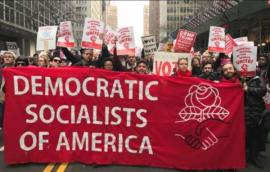
The Left Alternative
At the moment, the broad left of American politics is held together by opposition to Trump, but with the mid-term victory and with the possibility of a Democratic Party president in 2020, there will be a tendency to divide over the question of what is desirable and necessary versus what is possible. The division in the Democratic Party between Sanders and other progressives and between progressives and standard issue Democrats will also be reflected in DSA. We could already see this in the debate over NYC DSA’s endorsement of Cynthia Nixon, who had supported Barack Obama and Hillary Clinton with their neoliberal policies, but who underwent an overnight conversion and could suggest that she was herself a democratic socialist. NYC DSA, with Moment folks playing a leading rule, opted for Nixon. If you cannot already feel the undertow, it is because you have not yet walked far enough into the water.
What then is the alternative? The alternative is a revolutionary Marxist perspective that, while recognizing revolution is not on the agenda, puts the emphasis on the dynamic of social and labor movements informed by the idea that if those movement become large enough and strong enough they will tend to demand an independent political expression, either by splitting the Democratic Party or by launching an independent movement. We should take much of inspiration, our strategies, and our fundamental political outlook from grassroots movement from below such as Occupy Wall Street, Black Lives Matters, and the West Virginia teacher strikes. We should also look attempts in the United States and abroad to build parties to the left of the Democrats and the Social Democrats. The reason for running candidates in the Democratic Party should be to represent those movements and forces that have the potential not to reform or capture the Democratic Party, but to lead to its crack-up, for clearly a new left political party will have to come out of a combination of the movements and of the working class base of the Democrats. All of this should be inspired by the idea that the goal is the complete overthrow of the capitalist system. The government we have can never represent the interests of working people and the oppressed—it needs to be dismantled and replaced by a different more democratic kind of government. While the level of community and worker struggles remains low, those should be where we see our future.
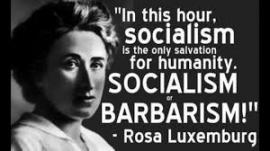
Some in DSA like to put these arguments in terms of the classical positions of the past. If that is the case, then we should see this as a moment for emphasizing Rosa Luxemburg, certainly not the German Social Democrat Karl Kautsky or the Italian Eurocommunist Enrico Berlinguer or even the Bolshevik Vladimir Lenin. We certainly don’t want to create today an organization that combines centralization plus reformist politics. The heart of Luxemburg’s politics was the idea of the dynamic interaction between the economic and the political, between the party and the self-activity working class and popular movements. The self-activity of working people and the oppressed, the notion of self-emancipation, should be for us as it was for Luxemburg at the center of our politics at this stage of the movement and this moment in history.
At the same time, of course, Luxemburg stood for a centralized party that could provide leadership to the working class, even if she differed with both Kautsky and Lenin about how such a party should be organized and should operate. DSA members have to decide that they want to both express the working class’s needs and desires and basing themselves in the working class to lead the working class toward revolution.
DSA remains the most dynamic and exciting organization on the left. As we head now into the unfolding crisis of the last years of the Donald J. Trump administration we in DSA will have an opportunity to decide and then to test our strategies and to draw lessons from the experiences. Two years later, the new DSA remains an exciting experiment, one that opens up important possibilities for the future and we should take advantage of them.
Dan La Botz is a member of both Solidarity and the Democratic Socialists of America, as well as an editor of New Politics.

.png)

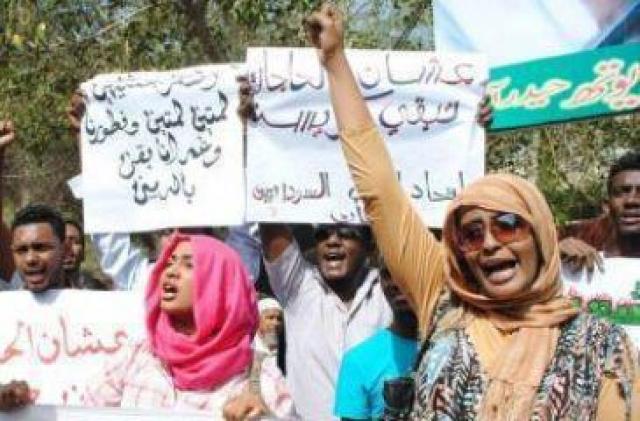
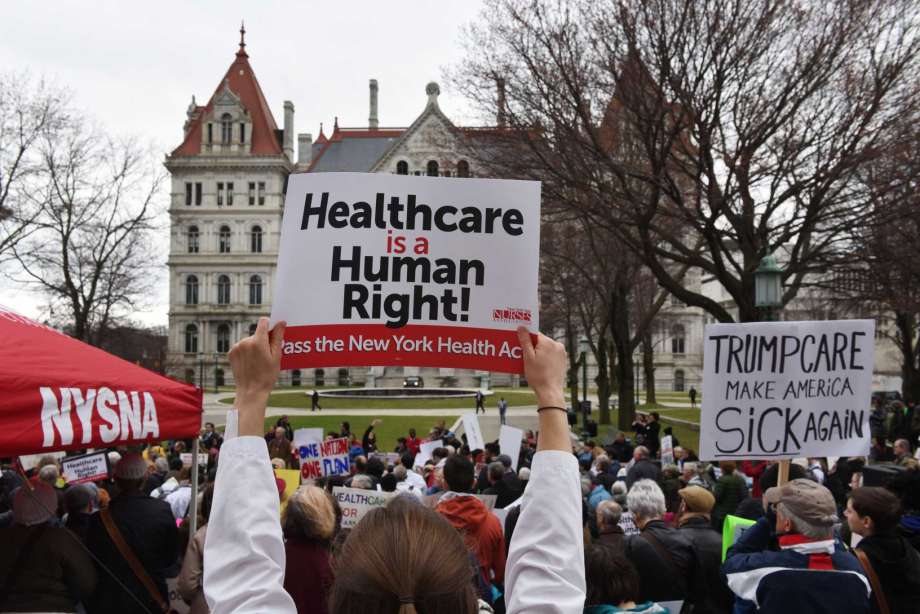















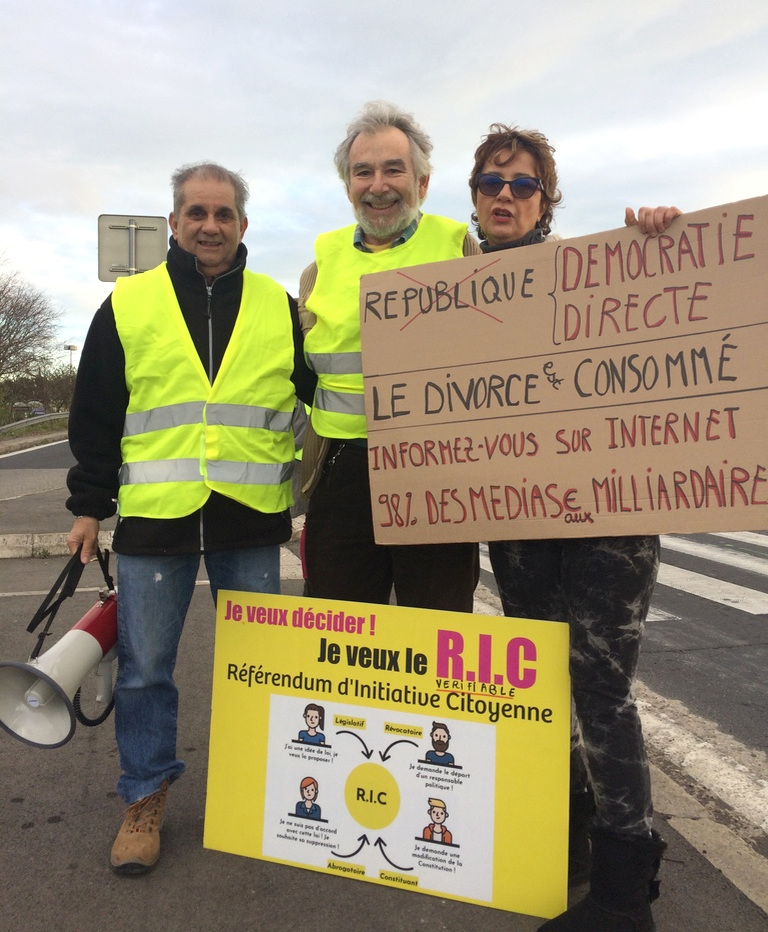 Is the
Is the 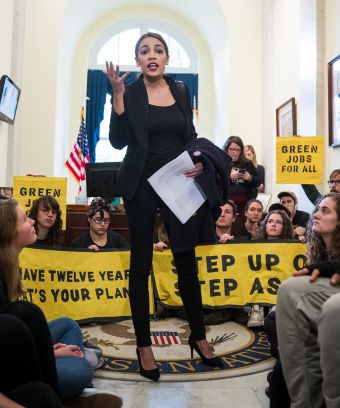
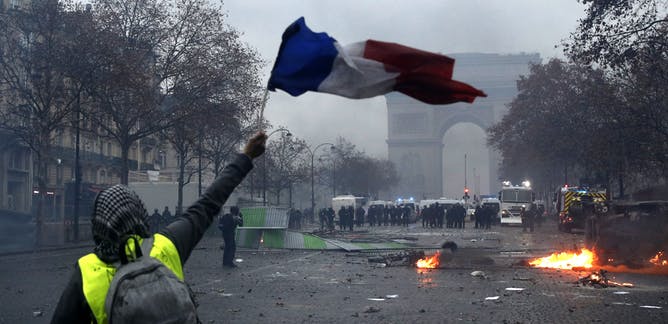





 In 2017 the Texas legislature passed a law forbidding the state from contracting with companies that refuse to do business with Israel. Some interpreted this broadly. After destructive flooding in Houston that year, one town told homeowners that if they wanted aid in rebuilding, they’d have to sign a pledge not to boycott Israel. After another type of flood – of bad publicity – the town said the boycott only applied to actual businesses in the town.
In 2017 the Texas legislature passed a law forbidding the state from contracting with companies that refuse to do business with Israel. Some interpreted this broadly. After destructive flooding in Houston that year, one town told homeowners that if they wanted aid in rebuilding, they’d have to sign a pledge not to boycott Israel. After another type of flood – of bad publicity – the town said the boycott only applied to actual businesses in the town.


 The following statement is from the Articulación de Movimientos Sociales, the coalition of social movements in Nicaragua.
The following statement is from the Articulación de Movimientos Sociales, the coalition of social movements in Nicaragua.